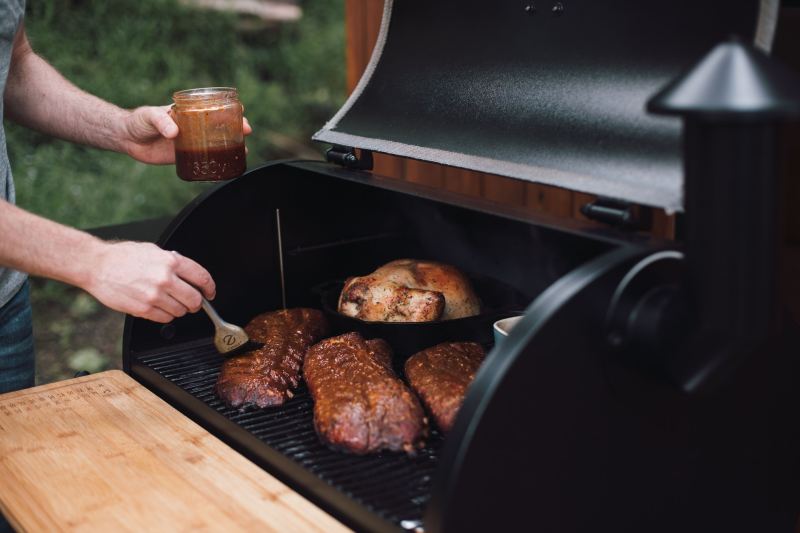Ribs are one of those dishes that are taken very, very seriously by those who love to cook them. Passionate arguments can break out at any cookout regarding proper cook time, smoking methods, whether to sauce or not, and the best ingredients for a mind-blowing spice rub.
Now, we’re not here to debate any of the above hot issues. Not today, at least. Today, we’re covering the basics of how to cook ribs on the grill.
Choosing the right ribs

Before firing up the grill, you’ll need to know what kind of ribs you’d like to cook. There are delicious pros to both beef and pork, depending on what kind of dish you’re after. Pork ribs are smaller, which means they will have a shorter cooking time. They’re also less fatty, making them a slightly (very slightly) healthier option, if that’s something you’re concerned about. Beef ribs, on the other hand, are bigger and fattier, which makes them more robust in their flavor, but adds considerable time to the cooking process.
No matter which kind of ribs you’re shopping for, it’s best to go directly to the butcher counter and avoid the shrink-wrapped stuff in the refrigerated section. This way, you can ask a professional behind the counter any questions you have. They can also do any trimming or butchering that you might need done, depending on the rib type you’re purchasing. Ask the butcher for their recommendation, which is freshest, which would be best for the dish you have in mind, and if they have any other insider recommendations. This is always the best way to buy your meat, no matter if you’re in the market for ribs, ribeyes, or chicken livers.
How long does it take to grill ribs?

The time your ribs spend on the grill depends on many different factors — whether they’ve been partially cooked already, the kind of ribs you’re cooking, and your preferred level of doneness. On average, ribs should be on the grill for one to two hours. At this point, they should be tender and moist but not completely falling off the bone.
The best way to check for doneness is by using a meat thermometer. This can be tricky because of how ribs are structured, but insert the probe directly into the meat, taking care that it’s not touching any bone. While technically safe to eat when the ribs reach 145 degrees Fahrenheit, this is one meat that tastes much better when “overcooked.” If you’re cooking your ribs low and slow, you’ll want an internal temperature between 180 and 190 degrees Fahrenheit.
Should ribs be wrapped in foil when grilling?

Wrapping ribs in foil helps seal in extra flavor and ensures extra tenderness by locking in moisture. The best way to do this is to season the ribs first, then create a loose pocket around them, giving air room to circulate.
When we have the time, we like to use the 3-2-1 rule when grilling ribs (more on this in a moment). This method involves cooking them both in and out of foil — inside the foil first to allow the ribs to cook gently, then outside the foil so the ribs can properly char and the sauce can caramelize.
What is the best technique for grilling ribs?

Some of the most popular summertime cookout fare, beef back and pork ribs, are absolutely delectable when cooked on the grill. Of course, you can always use the oven in lieu of the grill, but there’s just something about that crispy, deliciously blackened char that ribs can only get from a grill’s open flame.
We don’t always necessarily put short ribs into the “ribs” category of our minds. They’re ribs, of course, but not necessarily the kind we think of slathered in barbecue sauce next to some buttery corn on the cob. Short ribs, we’d argue, are more often thought of as comfort food — a wine-braised wintertime dish served atop pillowy mashed potatoes. But short ribs are surprisingly wonderful when prepared on the grill. Because this savory cut comes from the chuck area of the cow, they’re perfectly marbled, which makes them rich, tender, and ideal after a trip over the flames.
What is the 3:2:1 method for grilling ribs?
This popular, easy-to-remember rib-cooking method is a very simple way to prepare deliciously tender ribs every time. While the method works for almost every kind of rib, it was designed specifically for spare ribs. While rub and sauce recipes or brands can be debated all day, this method will work around just about any of your favorite recipes. The method is as follows:
- 3 hours – Time spent smoking the ribs
- 2 hours – Time spent grilling the ribs in foil
- 1 hour – Time ribs are grilled outside of the foil and slathered in sauce
Poaching shortcut
While we love the 3-2-1 method for cooking ribs, we don’t always have six hours to spend on them. Our favorite shortcut involves something you might not have thought to do with ribs before — poaching. When making ribs (in a reasonable amount of time), we always recommend poaching them first. While some may think this an unnecessary step, it actually has several delicious benefits.
First, you can add flavor to your ribs by poaching them in your favorite flavorful liquid, like beer or cider. Alternatively, you can always season plain water with your favorite herbs, spices, and other ingredients with great flavor you’d like to infuse into your ribs.
Second, by simmering your ribs before grilling or baking them, you’re cutting your cooking time in half by cooking away some of the tougher muscle fibers that ribs can have. As delicious as ribs are, they can be tough if you haven’t properly cooked down these tough proteins. Simmering ribs first guarantees a more tender rack of ribs.




